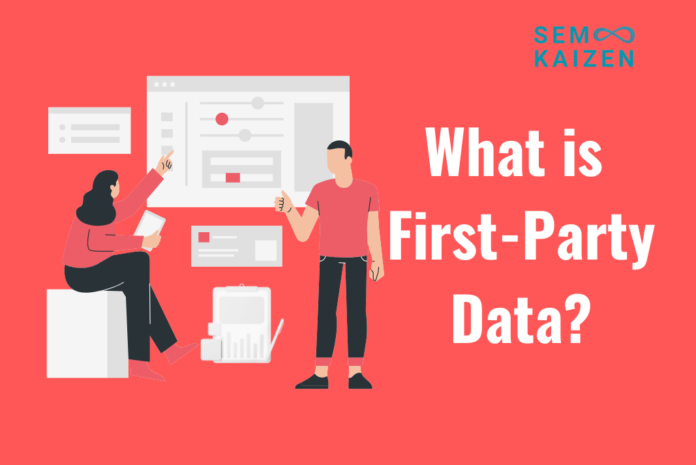Data is the new Oil and Information is the new Gold! With growing concerns about privacy and user tracking, businesses are re-evaluating how they collect and utilize data. This is where first-party data comes in – a powerful tool for understanding your audience and building stronger relationships.
Understanding First-Party Data
First-party data is the information collected directly from your audience or customers. This data is gathered through interactions that occur on the brand’s owned channels, such as the brand website, mobile app, social media pages, or email communications.
The key characteristic of first-party data is that you collect it directly from the source without intermediaries, making it highly reliable and relevant.
Data Types
You can categorize data into four: first-party data, second-party data, third-party data, and zero-party data. Each data type confers a different set of benefits and challenges.
| Data Type | Definitions | Examples | Advantages | Limitations |
|---|---|---|---|---|
| First-Party | Data collected directly from your audience/customers | – Customer emails – Purchase history – Website analytics | – High accuracy – Complete control – Enhanced insights | – Limited scope – Time-consuming to collect and manage |
| Second-Party | Another company’s first-party data shared through partnership | – Hotel & airline customer data sharing – Retailer purchase data | Another company’s first-party data shared through a partnership | – Trust and partnership required – Legal considerations |
| Third-Party | Data collected by entities without direct customer relationship | – Demographic data from brokers – Behavioral data from analytics companies | – Broad audience reach – Fills data gaps – Useful for large campaigns | – Privacy concerns – Less accurate – Potentially outdated |
| Zero-Party | Data intentionally shared by customers | – Customer feedback – Profile preferences – Quiz responses | – High accuracy – Builds trust – Facilitates personalization | – Limited volume – Reliant on customer willingness to share |
Types of First-Party Data
First-party data can include various types of information:
- Demographic Information: Age, gender, income, education level, etc.
- Behavioral Data: User interactions on your website, purchase history, product preferences, use of coupons & discounts, etc.
- Transactional Data: Purchase details, subscription information, order value, etc.
- Engagement Data: Email open rates, click-through rates, social media interactions, etc.
- Loyalty program or membership status: Whether the customer is a member
Why First-Party Data Matters?
Accuracy and Relevance
First-party data is inherently accurate and relevant because it comes directly from your audience’s interactions with your brand. This accuracy allows for more precise targeting and personalization in marketing efforts, leading to better customer experiences and higher conversion rates.
Privacy Compliance
With increasing regulations like GDPR and CCPA, privacy and data protection have become paramount. First-party data collection is more compliant with these regulations since users willingly provide this information, often with explicit consent. This reduces the risk of legal issues related to data privacy.
Enhanced Customer Insights
By analyzing first-party data, businesses can gain deep insights into customer behavior and preferences. This understanding helps in creating more effective marketing strategies, improving product offerings, and enhancing customer satisfaction.
Cost Efficiency
Relying on first-party data can be more cost-effective than purchasing third-party data. Since you collect it directly from your audience, there’s no need to pay intermediaries for access to customer information. This can lead to significant cost savings over time.
Building Trust and Loyalty
When customers share their data directly with your business, it fosters trust and loyalty. They feel more comfortable knowing that their information is being used responsibly and transparently. This trust can translate into long-term customer relationships and brand advocacy.
How to Collect First-Party Data?
Collecting first-party data involves gathering information directly from your audience through channels you own, like your website, mobile app, emails, or in-store interactions.
To effectively collect and utilize first-party data, businesses can employ various strategies:
1. Website and Mobile App Tracking
- Set up analytics tools like Google Analytics or Mixpanel to track user behavior, interactions, page views, session times, and conversion events.
- Google’s First-Party Mode can collect First-Party data from your domains directly.
- Use cookies or tracking pixels to understand user journeys, from page navigation to specific actions, helping you personalize future interactions.
2. Email Marketing and Newsletters
- Collect emails through subscription forms and use them to send newsletters, promotions, and updates.
- Use email metrics (opens, clicks, bounces) to segment your audience based on engagement, tailoring content to each segment’s interests and preferences.
3. Customer Surveys and Feedback Forms
- Use tools like SurveyMonkey, Typeform, or Google Forms to gather direct feedback on customer satisfaction, product preferences, or service expectations.
- Consider adding feedback forms at various touchpoints, such as post-purchase or post-interaction, to get timely responses.
4. Registration and Account Creation
- Encourage users to create accounts on your website or app, which helps you gather basic demographic data like name, age, and location.
- With each login, you can track individual user behavior and preferences over time, building a comprehensive profile.
5. Customer Relationship Management (CRM) Systems
- Use CRMs like Salesforce, HubSpot, or Zoho CRM to capture interactions with prospects and customers.
- Track details like purchase history, previous communications, and engagement levels, which provide valuable insights for personalizing outreach.
6. Transactional Data Collection
- For e-commerce businesses, purchase data is a rich source of first-party data. Track products viewed, abandoned carts, completed purchases, and repeat buying behavior.
- Use platforms like Shopify or WooCommerce to manage and analyze transaction data, helping you understand buying patterns and customer value.
7. Loyalty Programs
- Implement loyalty or rewards programs to encourage customers to share their preferences and interactions in exchange for benefits.
- Track usage patterns, reward points, and redemption rates, which can offer insights into customer loyalty and brand affinity.
8. Social Media Engagement
- Use social media management tools to capture data on customer interactions, engagement (likes, comments, shares), and responses.
- Run social media polls and surveys to directly gather audience preferences and opinions on your channels.
9. In-Store Interactions (If Applicable)
- If you have physical locations, capture data at point-of-sale (POS) or through customer loyalty apps that link offline behavior to online profiles.
- Use feedback kiosks or QR codes that link to surveys, allowing in-store customers to provide feedback digitally.
10. Custom Forms and Interactive Content
- Use custom forms, quizzes, and interactive tools on your website or app to gather data about preferences, needs, and demographic details.
- Tools like ConvertFlow and LeadSquared offer interactive lead capture and segmentation features that help refine your audience profiles.
List of First-Party Data Tools
1. Google Analytics

Google Analytics is a popular web analytic tool that tracks and reports website traffic. It provides insights into user behavior, demographics, and acquisition channels. By implementing GA on your website, you can monitor page views, session durations, bounce rates, and more, enabling you to understand how users interact with your site and identify areas for improvement.
2. HubSpot

HubSpot is an inbound marketing, sales, and customer service platform. It offers tools for email marketing, social media management, and customer relationship management (CRM). HubSpot’s CRM system allows you to collect and organize contact information, track customer interactions, and analyze engagement metrics, providing a comprehensive view of your customer base.
3. LeadSquared

LeadSquared is a sales execution and marketing automation platform designed to streamline lead management. It enables businesses to capture leads through customizable forms, landing pages, and email campaigns. LeadSquared tracks leads and scores them based on engagement, and automates follow-up processes, ensuring efficient lead nurturing and conversion.
4. Shopify

Shopify is an e-commerce platform that allows businesses to set up online stores. It collects first-party data through customer accounts, purchase histories, and browsing behaviors. Shopify’s analytics tools provide insights into sales performance, customer demographics, and product trends, helping merchants tailor their offerings and marketing strategies.
5. Salesforce

Salesforce is a customer relationship management (CRM) platform that offers a suite of enterprise applications focused on customer service, marketing automation, and analytics. It enables businesses to collect and manage customer data, track interactions, and analyze customer journeys, facilitating personalized communication and improved customer satisfaction.
6. ConvertFlow

ConvertFlow is a platform that allows businesses to create personalized website experiences without coding. It offers tools for building dynamic forms, pop-ups, and landing pages to capture leads and segment audiences. By integrating with your website, ConvertFlow helps collect first-party data by engaging visitors with targeted messages and offers based on their behavior and attributes.
Challenges of First-Party Data
While first-party data offers numerous benefits, it also comes with challenges:
Data Management
Collecting and managing large volumes of data can be complex. Businesses need robust data management systems to ensure data accuracy and accessibility.
Integration
Integrating first-party data across different platforms and touchpoints can be challenging. Ensuring that all collected data is cohesive and can be analyzed effectively requires advanced integration tools and strategies.
Ensuring User Consent
Obtaining and managing user consent in compliance with data protection regulations is essential. Businesses must be transparent about their data collection practices and provide easy ways for users to opt out if they choose to.
Wrapping Up
First-party data is a powerful asset for businesses looking to understand and engage their audiences more effectively. Its accuracy, relevance, and compliance with privacy regulations make it an invaluable resource in the modern digital landscape.
By leveraging first-party data, businesses can create more personalized and effective marketing strategies, build stronger customer relationships, and ultimately drive growth. While there are challenges associated with collecting and managing this data, the benefits far outweigh the drawbacks, making first-party data an essential component of any data-driven strategy.
Subscribe to Our Newsletter!

